Webcast to Discuss Downwind Aero Project
Published on January 30th, 2017
Researchers of the Downwind Aero Forces and Moments project supported by the Sailing Yacht Research Foundation (SYRF) have just completed Phase 2C, the last of a suite of studies in this project, with the report available online now in the SYRF Library.
Aerodynamic modelling of downwind sails has been the significant challenge for sailmakers and rating rule technicians for decades, with many different approaches tried in both wind tunnel and CFD (computational fluid dynamic). The purpose of the Downwind Aero project was to identify the CFD methodologies needed to generate consistent results in the forces and moments calculated through the modelling process.
Phase 1 of the study (published in February 2016) provided the moments and forces for a range of downwind sails at Apparent Wind Angles (AWA) greater than 130°, and Phase 2A was designed to expand the initial dataset to include tighter AWA data with simulated custom tight angle sails, compared to the Phase 1 sails which were based on produced sail designs. Phase 2B (published November 2016) sought to quantify the effect of increasing and decreasing the girths of the mainsail and gennaker.
A particular challenge in modeling lightly loaded downwind or wide AWA sails is the tendency for the shape to oscillate, thus making it difficult to obtain a steady state convergence. Phase 2C made enhancements to the Fluid-Structure Interaction (FSI) process, including a gradual change in pressure from one coupling to the next, which, when applied, introduces sub-iterations in between the FSI couplings. These sub-iterations can help smooth the effects of the S or A-Sail oscillations, allowing for more accurate comparisons.
“The wider the wind angle, the more drag and less lift,” explains SYRF Board member Jay Hansen. “The more drag and less lift, the more difficult is achieving accurate modeling. One of the fears is that while we have great confidence in an improved modeling of boat performance up to 45 AWA and reasonable confidence from 45 to maybe 100 degrees, it’s the optimum downwind angles, particularly the wider angles for older boats, that should make us nervous. It can be done, but with significant time and expense.
“As we sailors know, downwind sails in light air can be unstable. However, to get a complete understanding of this instability requires dynamic modeling, something too difficult to achieve now in a practical and cost effective manner. What JB and Michael have shown with their 2C work is that their new methodology allows the RANS methods to smooth out the results through varying sheet tensions, ensuring consistency in the data. And, it’s consistency, not absolute results, that is important for us.”
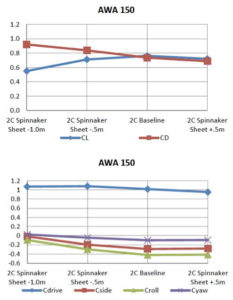
Graphic depiction of force coefficients at 150 TWA, showing crossover between lift and drag regimes and the effect of trim variations
North Design Services’ JB Braun, Michael Richelsen, and Mike Schreiber and Wolfson Unit’s Sandy Wright will be available on Wednesday, February 8th for a public webcast where they will explain the significance of this study, and will be available to answer questions.
Details for this special event are available as follows:
SYRF Downwind Aero 2 – Ask JB
Wed, Feb 8, 2017 11:00 AM – 12:00 PM EST
Please join my meeting from your computer, tablet or smartphone.
https://global.gotomeeting.com/join/745407101
You can also dial in using your phone.
United States: +1 (224) 501-3412
Access Code: 745-407-101
First GoToMeeting? Try a test session: http://help.citrix.com/getready
For more information on SYRF, visit www.sailyachtresearch.org.
Source: SYRF


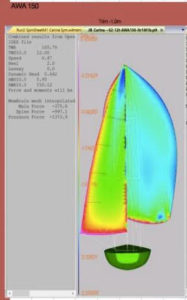




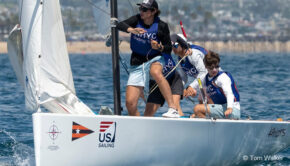
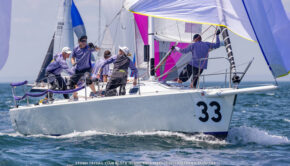
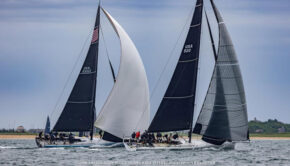
 We’ll keep your information safe.
We’ll keep your information safe.